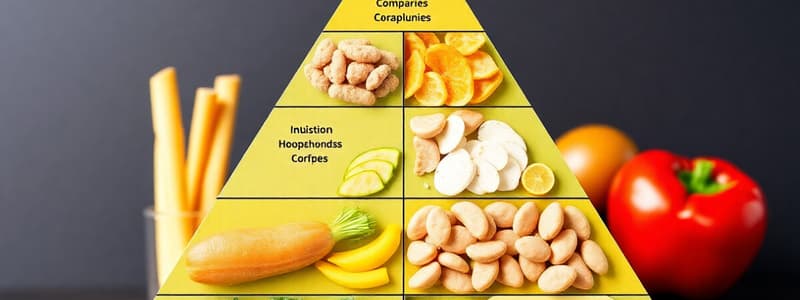Podcast
Questions and Answers
How do dietary guidelines primarily get developed?
How do dietary guidelines primarily get developed?
- Based solely on expert opinions from nutritionists.
- Based on trends and celebrity endorsements.
- Based on population needs and review of scientific evidence. (correct)
- Based on agricultural production and economic factors.
During adolescence, what are some of the key nutrients that are needed in higher quantities compared to other life stages?
During adolescence, what are some of the key nutrients that are needed in higher quantities compared to other life stages?
- Calcium, Iron, and Energy (correct)
- Zinc, Copper, and Selenium
- Vitamin C, Vitamin D, and Potassium
- Sodium, Chloride, and Magnesium
Why do older adults often require increased nutrient density in their diet, even as their caloric needs decrease?
Why do older adults often require increased nutrient density in their diet, even as their caloric needs decrease?
- To promote rapid weight gain and muscle building.
- To compensate for decreased absorption and utilization of nutrients. (correct)
- To support increased physical activity levels common in older age.
- To counteract higher metabolic rates.
How does physical activity level primarily affect macronutrient needs regarding carbohydrates, proteins, and fats?
How does physical activity level primarily affect macronutrient needs regarding carbohydrates, proteins, and fats?
Besides folate, iron, and calcium, what other primary nutrient is particularly critical during pregnancy for fetal brain and eye development?
Besides folate, iron, and calcium, what other primary nutrient is particularly critical during pregnancy for fetal brain and eye development?
Which physiological factor has the most influence on individual nutrient needs?
Which physiological factor has the most influence on individual nutrient needs?
How is nutrient bioavailability affected by environmental factors?
How is nutrient bioavailability affected by environmental factors?
What impact do chronic diseases like diabetes and cardiovascular diseases typically have on an individual's nutritional needs?
What impact do chronic diseases like diabetes and cardiovascular diseases typically have on an individual's nutritional needs?
Flashcards
Nutrient Needs: Influencing Factors
Nutrient Needs: Influencing Factors
Nutrient needs vary based on factors like age, gender, activity level, pregnancy, and environment.
Dietary Guidelines
Dietary Guidelines
Guidelines developed based on population needs and scientific evidence, often visualized as a food pyramid.
Infancy and Childhood Nutrient Needs
Infancy and Childhood Nutrient Needs
During these stages nutrient density is important to ensure proper growth and devlopment
Adolescence Nutrient Needs
Adolescence Nutrient Needs
Signup and view all the flashcards
Gender-Based Nutrient Differences
Gender-Based Nutrient Differences
Signup and view all the flashcards
Nutrient Needs and Physical Activity
Nutrient Needs and Physical Activity
Signup and view all the flashcards
Pregnancy Nutrient Needs
Pregnancy Nutrient Needs
Signup and view all the flashcards
Health Status & Nutrient Needs
Health Status & Nutrient Needs
Signup and view all the flashcards
Study Notes
- Nutrient needs are influenced by various factors
- Factors include age, gender, physical activity, pregnancy and environment
Dietary Guidelines
- Dietary guidelines are recommendations for what to eat
- They are developed based on population needs and scientific evidence
- Visual aids like food groups or dietary pyramids represent the guidelines
Food Pyramid
- The food pyramid is a visual, dietary guideline
- It contains grains, vegetable, fruits, fats, milk, and meat/fish/eggs/beans
Age
- During infancy and childhood there is rapid growth and high nutrient needs
- During adolescence, higher energy, calcium, and iron needs are required
- Adulthood requires the maintenance of health, energy, and metabolism
- Decreased caloric needs but increased nutrient density for older adults
Gender
- Males and females have differences in body composition and metabolism influencing nutrient needs
- This results in varying iron and calcium needs
- Considerations such as menopause creates hormonal differences
Physical Activity
- Active individuals expend higher energy compared to sedentary ones
- Macronutrient intake depends on activity level and includes carbs, protein, and fats
- Hydration and electrolyte balance are important
Pregnancy
- Key nutrients during pregnancy include folate, iron, calcium, DHA, and protein
- Adjustments to diet are necessary during pregnancy and lactation
- Malnutrition during pregnancy creates risks
Environment
- Climate, urbanization, access to food, and socioeconomic factors affect nutrient intake
- Nutrient bioavailability and exposure to environmental pollutants impacts nutrient status
- City versus rural environments and sustainable versus processed foods influence nutrient intake
Health status
- Health status and nutrition can depend on chronic illness such as diabetes
- The immune system and nutrition are related
- Nutrient absorption is impacted by stress, medications and illness
Body Composition
- Body composition (muscle vs. fat) influences nutrient needs
- Basal metabolic rate (BMR) is a factor
Studying That Suits You
Use AI to generate personalized quizzes and flashcards to suit your learning preferences.
Related Documents
Description
Explore the factors influencing nutrient needs, including age, gender, physical activity, pregnancy, and environment. Learn about dietary guidelines, their scientific basis, and visual aids like the food pyramid. Understand the varied nutrient requirements across different life stages and genders.




